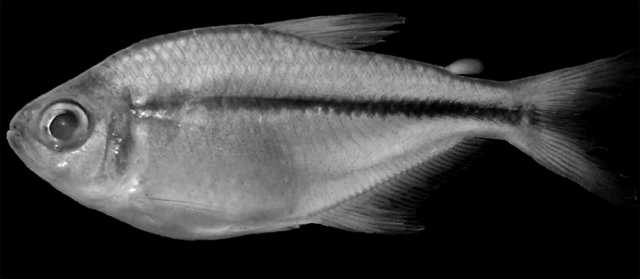| Characidae (Characins; tetras), subfamily: Stethaprioninae |
| 4.277 cm SL (male/unsexed) |
|
benthopelagic; freshwater; pH range: 6 |
| South America: Orito River in Putumayo drainage, Colombia. |
|
Dorsal soft rays (total): 11-11; Anal soft rays: 30-31; Vertebrae: 34-35. Diagnosed from other species of the genus Hyphessobrycon by the following characters: dorsal fin with 3 simple and 8 branched rays (vs. 2 simple and 9 branched rays, except Hyphessobrycon notidanos with iii, 8); anal fin with 4 simple and 26-27 branched rays (vs. 3 simple and 17-24 branched rays); dentary teeth 19 (vs. 6-12); scales on lateral line 35 (vs. 31-34, except for Hyphessobrycon heterorhabdus with 37); pored lateral line scales 10-11 (vs. 8-9); longitudinal scale rows from the lateral line to the dorsal fin 7 (vs. 5, except in Hyphessobrycon heterorhabdus with 7) and predorsal scales 14 (vs. 10-11). Differs from a very similar species Hyphessobrycon notidanos by the possession of the following characters: lateral line scales 35 (vs. 32-34); pored scales 12-14 (vs. 9-11);
scale rows between dorsal-fin origin and lateral line 7 (vs. 6); predorsal median scales 12-14 (vs. 9-11); teeth in the dentary 19 (vs. 7); teeth in the maxillary 5-6 (vs. 2-4); dorsal-fin rays iv, 26-27 (vs. iii, 17-20); body depth 37.84-45.59% SL (vs. 36.84-37.79% SL); and snout-anal fin distance 56.71-65.05% SL (vs. 62.52-80.39% SL) (Ref. 76880).
Description: P ii,10-11; V ii,6-7 (Ref. 76880). |
| Occurs in clear water over substrate of sand and stone (Ref. 76880). Feeds on insects and plant matter (Ref. 76880). |
|
Least Concern (LC); Date assessed: 09 October 2014 Ref. (130435)
|
| harmless |
Source and more info: www.fishbase.org. For personal, classroom, and other internal use only. Not for publication.

